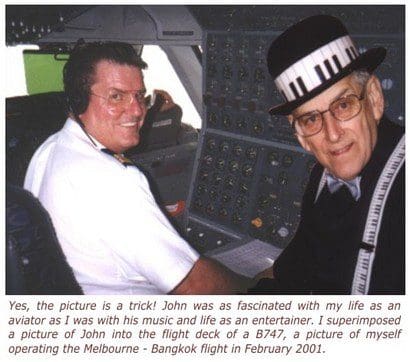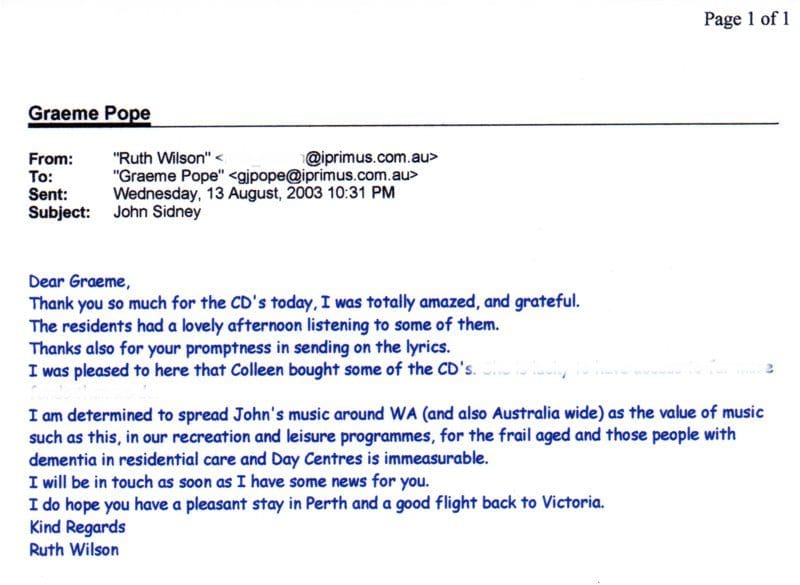THE MUSIC OF JOHN SIDNEY AN AVIATOR'S PASSION
By Graeme Pope (September 2004 )

A chance meeting
During 1997 and 2000 I was flying with a company operating B727 freighters within Australia. Every third or fourth weekend I was rostered to spend a four day weekend in Hobart, Tasmania. As fate would have it, during one of those weekends in November 1998, I met John Sidney, a well-know entertainer from Tasmania.
I was making a phone call in the foyer of a hotel when I heard a piano begin to play right on 12 noon. To this day, I still marvel at that. I was at the hotel briefly to make a reservation. Why, on leaving the hotel I took coins from my pocket to use the pay phone to call home when I could have returned to the company accommodation to make a free call, I don’t know, but it was this delay at the pay phone that was the key to my meeting John.
John played the piano at this hotel each Sunday lunchtime for two-and-a-half hours. As a lover of piano music, I couldn’t wait to investigate the wonderful sound coming from the dining room. I was enthralled and ordered lunch so I could stay and listen to John’s complete performance. After his last note I moved to the piano and introduced myself.
John was promoting his music by selling eleven home-recorded audio tapes. I was so impressed with his style on the keyboard that I bought the whole set. I just loved his playing and, later, as I listened to the tapes, I recalled all those lovely old tunes my mother had played on the piano at dance halls; I grew up in the tail end of that era, and remember those years very well.
Friendship and music
It was almost three months before my next rostered weekend in Hobart, so I was more than a little concerned that after so long John mightn’t be playing at the hotel. Fortunately, he was and it was this second meeting that formed the beginning of what would become a lasting friendship.
John’s style of playing was unique; very much family-round-the-piano’ type of music, just as it was before television. I knew once John’s generation passed on, so too would that style of playing. I was also keenly aware that it was almost impossible to buy this type of piano music in music shops, particularly good quality studio recordings. I therefore began to think about how best to preserve John’s works for the future.
During my second meeting with John I asked if I could put his tapes onto CD so they’d be easier to preserve. At that time I knew absolutely nothing about putting music onto CD but I was about to learn. The next time I saw John, I had not only transfered his music onto CD for my own collection, but delivered a number of CDs to him to sell along with his tapes.
Some time later, I asked him if he would go into a recording studio in Hobart so we could professionally record his works for my own personal collection. John was chuffed by this and towards the end of 2000 we entered the studio to record what would later be known as Easy Listening Piano Volumes 1 and 2, followed by Easy Listening Piano Volumes 3 and 4 in early 2001.
New beginnings
Some time later I was again in Hobart on one of my trips, John called by my hotel room to pick me up to go to one of his performances. At that time I was doing a lot of work on my computer for the airline, and when John noticed my computer, he asked me if I would put him on the Internet. John knew nothing about computers and assumed anyone who knew anything about computers, knew everything about computers. Little did he know, I knew little of the Internet then myself – sending and receiving mail was about it. I didn’t let him know of my limited knowledge, of course, and just said okay.
I was just over the steep learning curve of transferring music from audio tapes to CD when it all began again with learning about the Internet. By the end of November 2001, I launched www.evergreenmelodies.com so John could begin to market his music to the world.
A man of many talents
John wasn’t just a great pianist, he was also a marvellous entertainer, magician and ventriloquist. John and his vent doll Charlie achieved their greatest levels of fame when John compered the Children’s show for six years on Hobart television. John also played piano live on television with fellow musician and organist Peter Richman on a program called Tea Time Tunes, which later became Teletunes. How I wished I could have witnessed those years. And while I frequently wish I had met John 30 or more years earlier, I have to continually remind myself of how privileged and grateful I am to have known him at all, albeit for just a few short years.
During the four years I knew John, I organised tours for him to mainland Australia where he would perform and entertain at retirement villages and nursing homes in and around Melbourne. John was the showman and I enjoyed working behind the scenes organising his shows, and producing and promoting his music. His shows were incredibly popular and every place wanted him back whenever he toured.
John was never in a hurry to leave after his shows and would happily mingle and chat with his audience. If he did rush off it was only ever to do another show. He was a very warm and kind person who was very well received everywhere we went. The elderly folk just loved him and their response to his music was really amazing.
The end of an era
It was 2002. Everything was going so well and John and I had so many plans. We were marketing his music on the internet and had recorded a number of new albums: both volumes of The Four Hands Of John Sidney, Ragtime Rhythms, Dance Music By John Sidney and Sing-A-Long With John Sidney.
Once I retired from flying we planned to go back into the studio to record more of his work, and we would expand his live performances to take in all of Australia. However, in mid 2002, when John was about to enter the studio to record two Christmas carol CDs, tragedy struck. On his way to the studio he tripped, fell and broke his left wrist. He never recovered from the accident and died on November 11 of the same year. He was aged 75.
Keeping the dream alive
Prior to meeting John my life had been largely devoted to the aviation industry but this brush with the entertainment world changed things. So by June 2003, newly retired and having finally come to terms with the loss of John, I vowed to do something serious with John’s music and dedicate myself to keeping it alive.
In John’s music I knew I had something unique and precious in my hands, and I wanted to maintain John’s dream of sharing it with the world, especially with those who would treasure it most – people living in aged care..
At that point, while I didn’t know how I would fulfill my promise, I did know that my belief in John’s ability and my enthusiasm for his music would help me find the way.
John had bequeathed me full ownership rights to his work and I had toured with him enough to realise the value of his music to elderly folk as I observed them responding to him and his music.
After John’s shows, the CDs seemed to evaporate off the table, so with this in mind, I thought selling his CDs myself shouldn’t be too difficult – oh how wrong this perception proved to be. I was back at that learning curve once again!
My first steps in marketing John’s music to aged care facilities began in Perth in July 2003. I took 100 CDs with me and it was an incredible challenge. After a couple of weeks in Perth I felt disheartened as the response hadn’t been at all what I expected. But then, as before, fate had its way once again, and I met Ruth Wilson who was the diversional therapist at Perth’s Waminda Hostel. Ruth’s enthusiastic response to John’s music and an email she sent me shortly after our meeting provided the emotional boost I needed to keep pushing on.
John's legacy lives on
Today, I’m proud to say there are more than 6000 John Sidney’s CDs being played in aged care facilities throughout Australia, and the feedback I have receive is wonderful. One aged care facility recently told me their music library had become redundant since the residents started listening to John’s piano!
If only John were still with us to hear this praise, I can just imagine how happy he would be to know his music is still bringing pleasure to those who love it most. And although it’s incredibly tough without John, , it is this kind of encouraging feedback that makes all the effort seem worthwhile.
I am eternally grateful to those working in the aged care industry who have supported and encouraged my wife Sandra and I in our efforts to share John’s music with their residents. I’m also sure the many elderly folk in care who enjoy John’s music are equally grateful to them for having embraced this music on their behalf. For them, it doesn’t get much better than this!
